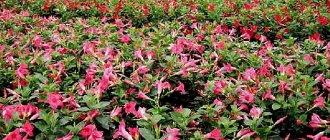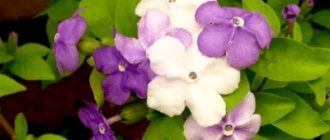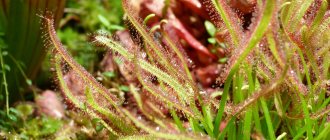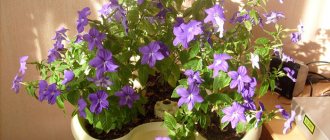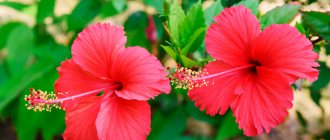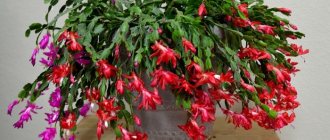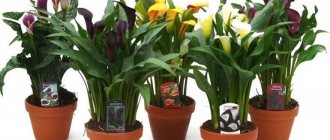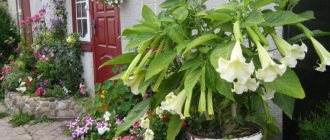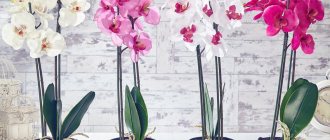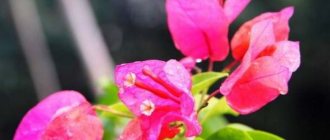Dipladenia is an exotic climbing plant. It has bright green leaves and fairly large flowers. The homeland of this flower is the subtropical part of Central and South America. In total, there are about 50 varieties of such plants in nature; they can be either in the form of shrubs or vines. Caring for dipladenia at home should be especially careful; it is important to choose the right air temperature and humidity.
Mandevilla-dipladenia - the queen of indoor vines
Diplademia is also known as mandevilla. This happened because they were simultaneously and independently discovered by two different scientists. At first it was believed that these were two different plants, then the confusion was sorted out and they were combined into one genus, but this plant still has two names.
Dipladenia at home
This ornamental plant belongs to the Kutrov family. Central and South America are considered its homeland. More than 40 species of mandevilla are known. Depending on the growing conditions, Dipladenia can grow into a flowering bush or become a decorative branching vine.
The stems of the flowering vine can grow up to 4 m. The leaves are dense, shiny and slightly elongated, they have a dark green color. Flowers can have different colors from white to red. They consist of five large petals arranged in a cone shape.
Up to fifty flowers can grow on one vine. The size of each of them is 5-12 cm. After the flower blooms, it lives for at least 14 days. Some varieties of Dipladenia have a pleasant aroma.
It must be remembered that this plant, although very beautiful, is nevertheless poisonous. Its juice is dangerous. Therefore, it should not be kept in homes with pets or small children.
Dipladenia loose
Used as an indoor or garden flower. Flowers create a pleasant aroma. The length of the stems reaches 4 m. The leaves are greenish-grayish in color and are up to 15 cm long. The size of the flowers is 5 cm. They are white or cream in color.
Note! This variety is characterized by good frost resistance. When grown in the garden in cold weather, it sheds its leaves. When used at home during the dormant period, this vine turns green.
Dipladenia Boliviana
This vine with a thin pink stem and small leaves (up to 4 cm long) is distinguished by beautiful pink flowers. They grow in the form of inflorescences of 5-8 pieces.
Description and characteristics
Dipladenia is a flower that is an evergreen perennial vine. Other names for the plant: Bolivian rose, Brazilian balsam, mandevilla or Chilean jasmine. Curly smooth shoots are covered with lush green leaves and funnel-shaped fragrant flowers about 10 cm in diameter. On one lash of a plant there can be up to fifty inflorescences. The color of the flowers is varied: they can be crimson, yellow, pink or cream. The flowering period lasts from early spring until approximately mid-autumn.
Dipladeniya flower requires special conditions of maintenance
For your information! After blooming, Dipladenia flowers retain their appearance for 10 days.
In nature, dipladenia grows mainly in South America. When grown in open ground conditions, the shoots of the flower stretch up to 5 m in length. The annual growth rate of the branches is about 70 cm in length. At home, the size of the vine can be adjusted by pruning. With proper care, Mandevilla Dipladenia will become the queen of indoor vines.
Dipladenia: care at home
Dipladenia ampelae or Mandevilla - home care
Mandevilla, Dipladenia is the queen of indoor vines, but only proper care will allow you to see luxurious tropical flowering.
Choosing soil for dipladenia
It is necessary to prepare the soil, which will be loose and can easily pass water and air for the roots of the plant. To ensure this, sand or small red brick chips are mixed into the ground.
The soil must necessarily contain a fertile layer. In this capacity, humus, soil from a greenhouse, or soil in which cucumbers were previously grown can be used. It is permissible to purchase commercial soil for dipladenia.
Luxurious tropical flowers
Watering and fertilizing mode
In its wild habitat, Dipladenia grows in tropical rainforest conditions. Therefore, it is important for it to provide similar conditions where it is going to be grown. To ensure constant air humidity, dipladenia needs to be sprayed regularly. You can also place it in a tray with a small amount of moistened gravel. As it dries, constantly add a little water. This is especially important to do during the period that begins with the opening of the buds and ends with the petals falling off.
Important ! When this vine blooms, it needs watering, which should occur twice a week. As soon as the top 2 cm of soil has dried, it is necessary to add moisture again.
This liana is very demanding on the quality of the water received. For this purpose, you need to use only filtered, boiled and cooled water.
Mandevilla likes the water to have minimal lime content. If you collect water from rain for irrigation, it will suit dipladenia well. However, this will only happen if the water is collected in rural areas.
In winter, the plant also needs watering, but the time for it comes provided that the soil is completely dry after the previous moisture and three more days have passed after that.
In order to provide the air suitable for the plant, you can use a humidifier. It is recommended that the percentage be 70%.
Important ! Under natural conditions, the vine grows in acidic soils. Therefore, it is recommended to add a little lemon juice or vinegar to the water. In the latter case, the smell must dissipate before use.
This plant needs feeding during the spring-autumn period. At this time, it is necessary to fertilize the flower 4 times a month. Any complex flower fertilizer is suitable for dipladenia. It should be taken into account that nitrogen fertilizers promote the growth of foliage and stems, while potassium and phosphorus fertilizers promote the formation of flowers.
Requirements for illumination of the place
This plant prefers good light, but does not tolerate direct sunlight. A good option for Dipladenia would be a shaded place on a sunny day.
It is recommended to choose the eastern side of the apartment to grow a flower. In the warm season, dipladia will feel comfortable on the balcony.
Flowers on the balcony
Features of caring for dipladenia at home
Dipladenia is an unpretentious vine with minimal requirements. If you follow them, the flower will delight you with abundant colorful blooms for many years.
Plant care rules:
- Illumination. The flower loves light, so it is recommended to place dipladenia near a window opening facing east. In summer, the vine is placed on a shaded terrace, in a shaded part of the garden.
- Temperature. Dipladenia loves warmth and develops well at a temperature of +23 degrees, withstands up to 35 degrees. If exposed to direct sunlight, it may dry out - do not keep the plant in the sun. In winter, in the room where Dipladenia lives, the temperature should not fall below +13 degrees.
- Humidity. In winter, the plant is placed as far as possible from the elements of the heating system. Liana feels comfortable at average air humidity.
- Watering. The flower loves systematic watering. During intensive growth, the plant should be watered promptly and abundantly. To prevent the root system from starting to rot from excess water, you should wait between waterings until the top layer of soil in the pot dries. For irrigation, it is recommended to use soft acidified water.
- Feeding. Complex fertilizing and fertilizer are used only during the season of flowering and intensive growth at intervals of 1 time per week.
- Earth mixture. Mandevilla is planted in moderately acidic fertile soil. To do this, use an earth mixture of a loose structure, consisting of sand, peat mixture, brick chips and perlite.
Winter is the plant's dormant time. During this period, the vine requires minimal watering and a temperature of +15 degrees. In order for the flower to live for many years and delight with beautiful flowering, it is recommended to adhere to the rules of replanting, propagation and ensure that pests do not settle on the mandeville: nematodes or mealybugs.
Dipladenia: growing and care in the garden
If a florist has started this plant, he must remember that care for dipladenia must be thorough and timely.
Mandevilla flower - home care
In October and November, it is customary to prune the plant. In this case, you need to carefully examine the plant and remove all old branches. Flowers in the garden grow actively only on young shoots.
Important ! You need to pay attention to old shoots that have not branched. They need to be shortened by 2/3 of the original length. Those that have already branched need to be pruned after the fork. In this case, cut off half or a third of the remaining branches.
Growing and caring for dipladenia at home suggests that pruning is important not only to ensure the growth of the plant, but also to form a beautiful bush.
It must be remembered that the juice of this plant is poisonous. Therefore, all work with it must be done with gloves.
It is necessary to grow a vine using a support. It is recommended that its height be one and a half times greater than an adult plant.
Recommendations for caring for mandevilla
To successfully grow a tropical beauty, it needs good care. The flower must be protected from drafts and provided with regular watering, spraying and fertilizing.
Watering with acidic water
Dipladenia, like all other tropical plants, needs abundant watering with warm water, but waterlogging should not be allowed, since stagnation of moisture can lead to rotting of the roots. In summer, the vine is watered every 2-3 days after the top layer of soil in the pot has dried. In winter, the number and volume of watering should be reduced.
In order for dipladeniya to bloom magnificently, it needs to be provided with abundant moisture.
It is recommended to acidify the water. To do this, add a little acetic or citric acid to the liquid. It is not difficult to check the degree of acidification; just taste it; the water should be slightly sour.
You need to constantly humidify the air
Brazilian balsam requires moist air. The plant must be frequently sprayed with warm water or installed next to the vine with a humidifier, a plate with wet pebbles, or an indoor fountain.
Necessary feeding
Since Dipladenia blooms profusely and for a long time, it requires a lot of nutrients. Fertilize the vine in the spring-summer period once every 2 weeks with complex mineral fertilizer for beautifully flowering plants. The drug Kemira Lux is perfect for this purpose.
Kemira Lux is a mineral fertilizer with a wide range of applications
The solution is made according to the instructions and applied to the soil 30 minutes after watering. In October, feeding is completely stopped.
Flowering period
In its natural environment, the liana can bloom all year round. “In captivity”, due to the reduction in daylight hours, mandevilla goes into a state of forced suspension of development and blooms again only in April-May.
Dipladenia blooms continuously for six months
The flowering period lasts six months, while buds are constantly formed. To prevent the plant from wasting extra energy, faded flowers must be periodically removed.
What to do in winter during the dormant period
For successful wintering, you need to prune the dipladenia at the end of October, leaving about 1/3 of the shoots on the plant. The liana is placed in a cool place with a temperature of +15–17 °C. Please note that the southern woman cannot tolerate temperatures below +12 °C. Hypothermia of the earthen clod is very dangerous, so it is recommended to place the pot with the vine in a wooden pot during the winter.
Watering in the fall is reduced. It is enough to moisten the earthen ball once a week. Feeding is canceled completely.
Correct cutting and shaping
Pruning mandevilla is a necessary technique that ensures abundant flowering, since buds form only on annual side shoots.
If you want a lush flowering plant, don’t be afraid to trim and pinch the dipladenia
The procedure is carried out in the fall, shortening all shoots by 2/3. In the spring, when the plant enters the phase of active growth, the tops are pinched for lush branching.
Planting in flowerpots
Freesia growing and care at home and in the garden
This hanging plant will look beautiful if grown in a hanging pot. It must be replanted at least once every two years.
If in the spring you notice that roots are coming through the drainage holes, then it’s time to move the flower to a new pot. If the roots do not stick out, then replanting this year is not necessary.
For planting, you need to prepare a suitable soil mixture. It should consist of humus, leaf soil, sand, peat and turf. The best time to plant Dipladenia is spring.
Dipladenia in landscape design
How does mandevilla reproduce?
There are several ways to propagate Chilean jasmine at home. To do this, the plant is cut, seeds are sown, or the tendrils are rooted after pruning.
Propagation by cuttings
Wisteria - care and cultivation at home
Cuttings are the easiest way to propagate Dipladenia. There are two ways to get new plants from cuttings: plant them in the ground or root them in water. In both cases, the cut site is treated with a growth stimulator.
Note! When placed in acidic soil - cut with or without roots - the cutting is covered with a transparent jar, creating greenhouse conditions.
Seeds and tendrils
In flower shops you can find planting material for Brazilian balsam in the form of seeds or get a seed pod from friends. In such cases, in order to get a new plant, you need to take into account certain rules for sowing seedlings:
- use of suitable slightly acidic loose soil;
- high air temperature (22-28 ºC);
- constant level of humidity without stagnant water.
Such conditions will have to be maintained for 2-4 months until the seeds germinate.
Dipladenia shoots from seeds will have to wait up to 4 months
It is much easier to propagate the plant with tendrils. To do this, young immature shoots are bent to the ground and pinned. When the roots appear, the young plant is separated from the mother plant and transplanted into a separate container, observing all transplantation requirements.
Temperature
During the spring-summer season, the most comfortable temperature for the plant will be 25 °C or higher. In winter, it is recommended to maintain it at 15 °C.
In summer it is important to provide the flower with ventilation. To do this, they take it out onto the balcony or place it next to the house, if possible. It must be remembered that the sun's rays falling on the leaves can cause burns. Therefore, at such times it is important to provide shade for the plant.
If dipladenia grows in an apartment, it needs regular ventilation. In this case, it is necessary to exclude the possibility of drafts.
Heat plays an important role in caring for the Dipladenia flower. The more it is, the juicier and brighter the flowers, the more actively this vine develops.
Since the daylight hours are much shorter in winter, the plant begins to go dormant. At this time, a lower temperature will be required for its comfortable existence. However, care must be taken that the air temperature does not fall below 13 °C.
Features of seasonal care
In its natural environment, Dipladenia grows intensively and blooms all year round. But at home it is difficult for her to provide year-round tropical conditions. Therefore, the plant needs to be provided with proper wintering. During this period, the vine is in a state of relative dormancy. Her growth is slowing down. It is recommended to keep the plant at a temperature of +12-15 degrees. The soil should not be allowed to overcool. The flowerpot can be placed on a foam or wood stand. The regularity of watering should be reduced in the fall. The soil layer should dry out deeper and deeper between waterings; in winter, it should be watered only after it has completely dried.
Why doesn't dipladenia bloom?
When dipladenia grows in the house, cultivation and care must be followed according to all the rules, otherwise flowering will not be achieved.
Although it is possible to plant this plant in open ground, it must be taken into account that it is very vulnerable to low temperatures. When the question arises about why dipladenia does not bloom, one answer may be that the temperature is too low.
How to make Dipladenia bloom at home
It may happen that this plant does not produce flowers at all. In this case, it can be assumed that he lacks the nutrients he receives from feeding. It can be made to bloom if you care for the plant properly.
Sometimes the reason is that the plant needs more light. It is important to avoid direct sunlight.
Why do Dipladenia leaves turn yellow and fall off?
Sometimes you can see that the leaves turn yellow and curl, and then dry out and fall off. The reason for this may be excessive watering. Excessive moisture causes plant disease.
If the vine freezes in winter, this can also cause the leaves to yellow and fall off.
If pests attack, you will need to apply appropriate insecticides.
Note! Sometimes the leaves shed intensively if the basic rules of care are violated. The cause can usually be poor watering, insufficient fertilizing and too dry air.
Spider mites and whiteflies
The greatest harm to dipladenia comes from spider mites and whiteflies, which can lead to the death of the plant if not properly cared for. Most often, their appearance is caused by inappropriate conditions and errors in care. Thus, mites appear when the leaves are insufficiently sprayed and the air is dry. In this case, you can see black or brown spots on the leaves themselves. Control measures depend on the degree of damage.
- For minor damage, periodic wiping of the leaves with acidified water and a small amount of liquid soap helps.
- For extensive lesions, it is best to use specialized products, for example, Fitoverm.
Plants that are taken outside can be affected by a pest such as whitefly. To prevent this, before bringing the flower into the house, carefully inspect it and rinse it with water. If infection cannot be avoided, then it is worth treating the flower with special pest control agents. The most important thing is to carry out treatment in a timely manner so that pests do not have time to infect most of the plantings.
Whiteflies in dipladenia
Dipladenia: reproduction
Dipladenia can be propagated using seeds or cuttings.
To plant seeds, the air temperature must be at least 29 °C. The soil should be loose and slightly acidic. It is moisturized, but not excessively. It is necessary to provide abundant but diffuse lighting.
Seed germination can take up to four months. Growing from seeds is much more labor-intensive compared to using cuttings for this purpose.
Dipladenia flower
Propagation by cuttings
To propagate Dipladenia by cuttings, you need to cut off the shoots of the vine in spring or summer. In the first case, they will still be green, but in the summer they will already become lignified.
Each cutting should have one stem node and 3-5 leaves. To propagate a flower, the branches must be cut at an acute angle and treated with a growth stimulator.
After this, you need to plant them in the ground. The soil mixture for growing should consist of peat, sand and sphagnum.
The cutting is covered with a bag or glass (for example, an inverted jar) and placed in a place where the temperature can be maintained at 25 °C. In this case, the cellophane must be removed for a while in order to ventilate.
After a month or a month and a half has passed, rooting will occur.
Dipladenia is a beautiful ornamental plant. However, it must be provided with suitable care. If everything is done correctly, this plant will delight the gardener with its beauty for many years.
Propagation by cuttings and other options
Dipladenia is propagated by cuttings. When is the best time to start breeding? The best time is early spring. They are cut with one pair of leaves. The cuttings are planted in cups separately and transferred to a warm place. Greenhouse conditions can be replaced by using plastic bags. Cups with cuttings are covered with bags on top. The substrate in this case includes peat, with a mixture of sand or perlite. When small sprouts appear - roots, the polyethylene is removed. Rooting takes approximately 45 days. After two months, the young plants are transplanted into more fertile soil. Before transplanting, moisten the soil. For rapid and efficient emergence of roots, cuttings are deepened to the first pair of leaves. Mandevilla should be kept indoors at plus twenty-five degrees.
Watering is carried out as needed. Usually the cuttings take root well, but occasionally the plant does not form a root system. Then another method comes to the rescue, but less effective - propagation by seeds. Seeds are sown in spring at 18 - 22 C.
In everyday life you will need:
- Washed and disinfected containers;
- Filling the container with soil: - 1 part deciduous soil plus 50% sand;
- The seeds are sown and sprinkled with sand;
- The earth is slightly moistened and covered;
- Seeds are ventilated every day;
- Sprouts appear after a few weeks;
- When the sprouts reach a height of 7 cm, they are transplanted separately.
There is also the option of propagation by antennae. This method is quite simple, but the effect is not always positive.
To implement it you need:
- Bend the top of the process to the ground plane;
- Fix or attach it in the area of the antennae (the area where it grows);
- Expect rooting.
The rooted shoot is separated and planted in another permanent place.
Features of planting and transplanting Brazilian balsam
Planting and replanting dipladenia have their own characteristics, stemming from the differences in the southernmost liana. We should not forget about this and carry out these operations that are significant for the plant, observing all the necessary rules.
Soil composition
To plant dipladenia, a fertile and rather acidic substrate is required. It can be made from the following ingredients:
- turf land (2 parts);
- compost (1 part);
- coarse sand (1 part);
- peat (1 part).
Experienced flower growers advise replacing a quarter of the required volume of sand with brick chips. This material is able to retain a significant amount of water, which allows for less frequent watering. If it is not possible to make a soil mixture yourself, you can purchase ready-made soil for pelargoniums or violets.
What should the pot be like, its dimensions
The container for an adult specimen should be about 30 cm in diameter and 15 cm in height. It must have drainage holes to allow excess moisture to flow freely into the pan.
When to replant after purchase
After purchasing dipladenia, it is not recommended to immediately replant the plant; it should acclimatize to the new location within one to two weeks.
Do not rush to replant the purchased plant, give it time to acclimatize
If you purchased dipladenia in winter, it is better to wait until spring and only then move it to a new pot with nutritious soil.
Transplant procedure
Dipladenia transplantation is carried out as follows:
A drainage layer of expanded clay or broken brick is placed at the bottom of the container.
A substrate is poured onto it, which should occupy a third of the pot. Dipladenia is removed from the old container, the soil is carefully shaken off the roots and they are washed in warm water.
The plant is placed in the middle of the new pot and the roots are straightened. A support is installed nearby, the size of which should be one and a half times the height of the planted plant. The voids are filled with soil, compacting it lightly. The soil is moistened with warm water. The vine is tied to a support and placed in a bright place.
In the first days after transplantation, the plant must be protected from bright light.
When the flower takes root, the shelter can be removed.
Difficulties in growing
Dipladenia requires care. The slightest shortcomings in agricultural technology can cause the development of diseases or the spread of pests.
Diseases
The most common problems:
- Rotting of the rhizome - as a result of stagnation of water or the use of soil contaminated with a fungus, the process of decomposition of plant cells begins. The situation is corrected by an urgent transplant with the removal of the old earthen clod and damaged roots.
- Rare and not abundant flowering is caused by a lack of light. The way out of the situation is to change the location or install phyto-lighting.
- Drying of foliage - the cause is dry air or burns from direct sunlight. All damaged leaves need to be removed, the humidity regime adjusted and the plant shaded.
Reasons why Dipladenia leaves dry out, turn yellow and fall off
The vital activity of the already mentioned spider mites can also influence the fact that dipladenia gradually turns yellow and its leaves fall off. Another signal of this may be red spots and the presence of a coating in the form of a cobweb on different parts of the flower.
Another pest that can reach the mandevilla is the mealyworm, which feeds on plant juices. It appears when poor water is used when caring for a flower, the temperature in the room is low, the vine does not have enough sunlight, or dirt accumulates on its leaves. It is this parasite that can influence the fact that dipladenia dries and fades.
A signal that it is time to start fighting this pest will be the flaccid leaves of the indoor specimen and its deformed buds. In addition, small mosquitoes may be visible near the container with the plant, and white larvae may be visible on the stems of the mandevilla itself.
The product is infused for 4 hours, cooled, and only after that is used to combat mealyworms: all affected parts of the plant are thoroughly washed. In addition, experts consider Aplaud and Phosfamide to be effective means.
Experienced craftsmen say that in order not to wonder why the leaves of indoor dipladenia turn yellow and fall off and it stops growing, it is necessary to carry out preventive measures in time:
- Constantly inspect the plant for insects.
- Replant mandevilla every year and do not forget to weed.
- Be sure to remove all old and dying parts, which in most cases are the cause of pests.
- Don’t be lazy and treat new containers for vines with boiling water.
Mandevilla transplant and substrate
The graceful indoor vine is replanted at the very beginning of the regrowth stage, as soon as there are signs that the plant is emerging from the dormant stage. Traditionally, transplantation occurs in February or March. Containers are changed even for adult manlevilles annually (only if the plants are large and difficult to handle without injury; replanting is carried out according to the needs of the plant itself, two or three times less often). A powerful, at least five-centimeter drainage is placed at the bottom of the containers.
For mandevillas of all types, it is extremely important to select nutritious soil mixtures with a loose texture. Ready-made substrates with a slightly acidic reaction or a mixture of 2 parts of turf, clay soil with 1 part of sand, leaf soil, and humus are suitable
For the plant, it is necessary to sterilize the substrate, because mandevillas are extremely vulnerable to root pests.
Good care matters
During the flowering period, it is important to know how many times the plant is fed. Mandevilla needs to be fed from April to September with an interval of 14 days. You can use a complex fertilizer - a set of several different types of fertilizers, balanced in their own composition, so as not to interfere with each other.
In this case, you will need the Flower Mix fertilizer - a concentrated nitrogen-phosphorus-potassium fertilizer, balanced in nutrients.
With the arrival of summer, the rules for caring for dipladenia do not change. It is important to provide dipladenia with the right amount of light. It is better to place the plant on a window that faces the east side. This way, the plant will get enough air.
If there is a balcony, then you can place the plant there. The main thing you should pay attention to is the temperature. Since, subject to low temperatures, dipladenia will have problems with flowering. Dipladenia is a tropical plant that blooms all year round (in its homeland).
However, in our area in the fall, the tropical flower switches to the “no development” phase. What can be done? Of course, you can illuminate the plant artificially, specifically from September. It is much easier to help Dipladenia stop growing entirely.
What should be done? Starting from the end of August, irrigation is gradually reduced. Pay attention to the watering mode. If in the summer the plant needed repeated watering and spraying, then with the onset of autumn you should not wait for the soil to dry out a little and water again. On the contrary, in the fall you need to wait until Dipladenia begins to gradually dry out as deeply as possible.
With the arrival of winter, mandevilla is watered 4 days after the soil has dried completely. The tropical vine is placed in an area where the temperature does not exceed plus fifteen, and also does not drop above plus twelve. Hypothermia of the earth clod is especially risky. Thus, it is preferable to place a pot of mandevilla in a box made of wood or plastic.
In order for Dipladenia to safely overwinter, it is essential to prune it at the end of October. Dipladenia is pruned in this way: the shoots of young plants are shortened by two-thirds. The same is done with branched shoots, but the counting is made not from the root neck, but from the fork on the trunk.
Why it is worth carrying out pruning manipulation:
- The tropical flower begins its flowering period on young shoots;
- In spring, a pair of fresh shoots are instantly formed.
When preparing for planting, it is necessary to first prepare a support for the flexible processes of dipladenia tending upward.
Dipladenia prefers oxidized soil. Therefore, peat is added to the soil. The introduction of peat is an acceptable method of improving the characteristics of the soil: porosity, density, air capacity, and moisture capacity of the soil. Watering the plant, and specifically the quality of the water, matters. It’s great if the water contains a minimum of lime. The best option is rainwater. However, boiled water without precipitation will do at home.
Types of Dipladenia domestica with photos and names
This flower includes more than 40 varieties of liana-like shrubs. Among them, the most famous plants are:
Dipladenia lucidum
Blooms in bright pink inflorescences of 5-6 flowers. As the plant ages, its stem becomes bare, without foliage.
Dipladenia laxa
It is distinguished by a powerful stem, abundantly flowering white semi-double inflorescences, resistant to low temperatures.
Dipladenia sanderi
Its main feature is a yellow throat framed by soft pink petals and small rounded leaves 5 cm long.
Pests and diseases
Among the dangerous pests, it is worth highlighting spider mites and whiteflies. Powdery mildew also affects the plant. Let's look at the main problems and methods to combat them.
- Falling and yellowing of leaves indicates excessive heat in summer or excessive cold in winter. To correct the situation, avoid overmoistening the soil and follow the watering schedule.
- Not abundant flowering, small flowers, pale leaves are a sign of lack of light. Shade the vine only on the hottest days in summer; in other periods the lighting should be good.
- Rapid shedding of flowers, as well as drooping and pale leaves indicate too low air humidity in the summer. Build a wide tray for the plant, pour wet expanded clay or pebbles into it. Spray the plant in the evening and morning. If the vine is growing in a pot in the garden, use a hose to thoroughly water the soil around the plant.
- Lack of nutrients also causes problems with flowering and growth. Fertilize throughout the summer to ensure flowering well into November.
- Over-wetting the soil causes root rot.
Guest from South America - dipladenia
Dipladenia, or as it is also called mandevilla, is a decorative deciduous evergreen vine. It is still rarely seen in the collections of Russian amateur flower growers, but in vain. A compact vine with glossy bright green leaves is a real decoration for any interior. Dipladenia blooms almost all summer. Flowers measuring 10–12 cm are beautiful and fragrant.
In natural habitats there are real jungles of Dipladenia
The liana grows in the humid tropics of Brazil, Mexico, Bolivia and other countries in South and Central America.
The flower has two names - dipladenia and mandevilla. The first plants found in the forests of the South American continent were called Dipladenia. Later, other species of Dipladenia were discovered, but they were mistakenly classified as a separate genus, which received the name Mandeville, in honor of Sir Henry Mandeville, an English diplomat and gardener. And both names are still in use.
The liana has two names: Dipladenia and Mandevilla.
Dipladenia is a perennial with shiny, leathery leaves ending in a characteristic pointed tip. The plant has a tuberous rhizome.
Among the people, the liana has received several romantic names: it is called the Mexican tree of love and Bolivian rose, Chilean jasmine and Brazilian balsam.
Brazilian balsam flowers have a variety of colors - from snow-white to cherry-red. Some types of dipladenia have a very delicate aroma and bloom for a long time from May to the end of autumn, with each flower pleasing others with its beauty for about 10–12 days.
Dipladenia can grow exclusively in tropical climates. In our country, it is grown in greenhouse or indoor conditions. The flower is poisonous, all its parts contain dangerous substances, so it is not recommended to grow it where there are small children. When caring for Dipladenia, you must also be careful and wear gloves when carrying out pruning, watering and other procedures.
Common types
The most common types of dipladenia:
- Sandera - a semi-climbing evergreen shrub, reaching a height of 3 m. Dark green shiny leaves of a dense structure are formed on the shoots. The flowers are pink with a yellow throat.
- Mandevilla loose - a deciduous representative, reaching 4 m in height. On the warty shoots of the flower, ovoid green leaves are located opposite. During the flowering period, it forms bouquets of 5–10 flowers. Flower color is white. The petals are corrugated at the edges.
- Dipladenia yellow - a beautifully blooming liana-like representative, characterized by its unpretentiousness in care. The leaf blades are shiny, green, and have a rigid structure. Yellow flowers form clusters of 3–5 pieces.
- Mandevilla is excellent - an evergreen plant, reaching a height of 3 m. The leaves are dense, green. Red flowers are collected in bouquets of 5–7 pieces.
Usefulness of the plant and harm
When caring for mandevilla, it is important to keep in mind that its sap has a strong aroma and is dangerous (in all parts of the plant). It is necessary to wear gloves when working with the plant. It is better not to have such a plant in a house where there are children and animals. Despite the disadvantages, there are still benefits from dipladenia. This plant forms the microclimate in the apartment. The plant absorbs carbon dioxide accumulated in the air and releases oxygen, absorbs harmful elements, microorganisms and dust formation. The invigorating smell emanating from homemade dipladenia flowers improves health, increases the body's activity and immunity. Dipladenia plant improves brain function and has a good effect on the functioning of the respiratory system.
Common diseases
Diseases in Mandevilla often occur as a result of poor care. Overwatering often leads to the appearance of fungal diseases. The most common of these is root rot. In addition, mandevilla is susceptible to powdery mildew and the bacterial disease Southern Wilt. Most problems can be solved by using antifungal drugs or home methods, but in some cases complete destruction of the plant is recommended.
Powdery mildew
One of the common diseases in mandevilla is powdery mildew. It appears as a thin white coating that covers the leaves of the plant. The disease is fungal and quickly affects all parts of the plant. To combat it, both folk remedies and specialized drugs are used. It is important to treat not only the affected areas, but the entire plant.
Lemon juice is used to treat the leaves. It is applied to the affected areas. A 1% solution of colloidal sulfur also showed high efficiency. The plant is treated with it. It is important to leave the sulfur on the leaf blades for a day. After this, the flower is washed with cool water. Powdery mildew can be defeated in 2-3 stages of treatment.
Root rot
Root rot often develops as a result of stagnant moisture and insufficient drainage in the pot. As a result, the roots begin to rot. First aid for root rot is replacing the soil and container. When the plant is replanted, all rotten areas are removed and the root system is treated with a fungicide. Then it is recommended to keep the flower without watering for the first time or to reduce it.
Advice! In case of root rot, it is recommended to completely change the substrate and container in which the plant grew.
One of the first signs of root rot development is the appearance of yellow spots on the leaves and their falling off. High soil moisture is a good environment for the development of various fungal diseases. The appearance of rusty or yellow spots is caused by fungi Corynespora Cassiicola, Cercospera. For the health of the plant, it is important to remove all yellow leaves and treat the dipladenia with a fungicide. The drug phytosporin is used most often. To increase efficiency, treatment is carried out 2-3 times with an interval of 10 days.
Southern Wilt Bacterial Infestation
Bacterial infection has three subtypes. They differ depending on the type of fungus that is in the soil. The disease may not manifest itself for a long time. Typically, this condition persists at low air temperatures. As soon as the air temperature rises, the fungus begins to multiply rapidly. Ultimately, it leads to the death of the entire vine. Bacteria remain in the soil for a long time.
The main signs of damage include:
- changing the shade of the leaves to yellow;
- the appearance of powdery spots on the top of the leaf;
- curling and drying of the lower leaves of the plant.
The disease cannot be treated. Affected plants are destroyed. The soil and pot in which they grew are thrown away. Lianas that were in close proximity to infected ones are carefully examined for infection. If no signs of infection are found, they are rearranged separately and treated repeatedly with fungicides.
Important! Southern Wilt bacteria can remain dormant for a long time. They affect not only the above-ground part, but also the roots.
